|
commonwealth railways, NSU model loco
Commonwealth Railways
NSU 7 1/4 inch gauge models
As this page is written its been about tweny five years since the beginning of the 'derbysulzers' web page. Over the years many requests were received from modellers to help with information with regard to the modelling of a variety of Sulzer powered locomotives & railcars. In response the modellers would often send pictures of those completed models, the images being truly appreciated.
Generally the models were OO/HO scale, but recently images were sent from Australia of a pair of Commonwealth Railways NSU models built to the 7 1/4 inch gauge.
The locomotives were built by Karl senior and brothers Karl junior (also known as Bill) and Mark. The views below show some of the highlights of the locomotive build and testing of the completed 'models'.
Whilst the actual man hours put into the construction of the locomotives was not recorded, it took about three years to complete the first two NSUs, since two thirds of the build team also had regular day jobs to deal with.
The fibreglass cab moulding took about two months to "get right" due to the curves and angles needed to make the moulds, this was the longest time spent on any part of the build. Many, many drawings were made and because more than one locomotive was to be built many parts were laser cut.
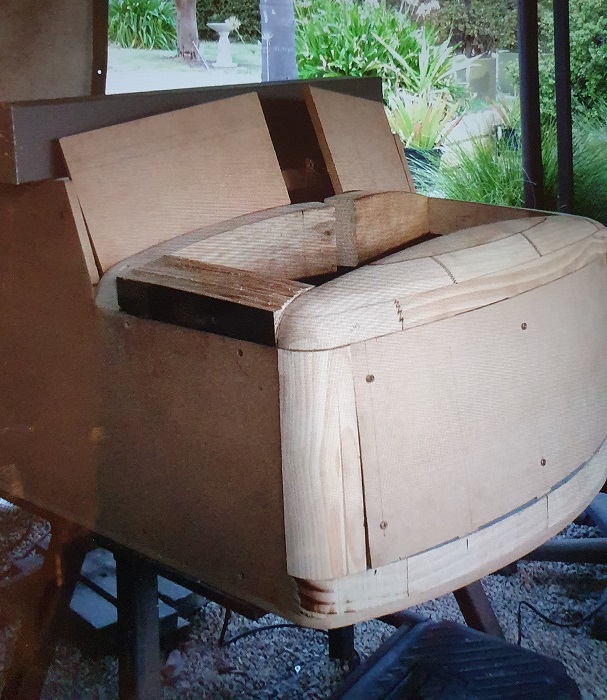
Early days in April 2020 as forms for the cab nose are created. The cab and nose would be moulded from fiberglass. The NSU Class locomotives have some subtle curves in the cab front area. When completed the wooden form was used to make multiple moldings.
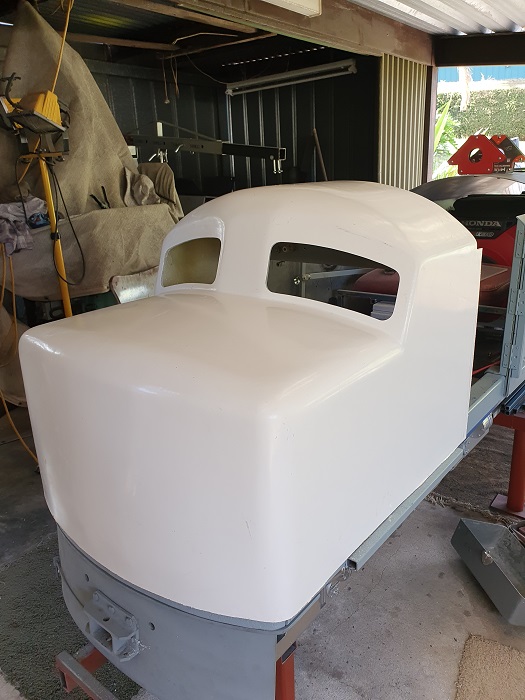
From the wooden forms would come the completed fibreglass cab and nose. Much needs to be done to add cabside windows, cab doors, various lights and louvred access panels to the nose area. The cab took the longest to "get right" due to the curves and angles needed to make the molds, about 2 months work. A lot of drawings were made and got many parts laser cut, due to that fact we were building more than one engine... many repetitive parts were made in this way.

The cabs have been added to the frames and much detail has been either carved out of the basic cab moulding or details have been added to it.

Its starting to look like a locomotive!
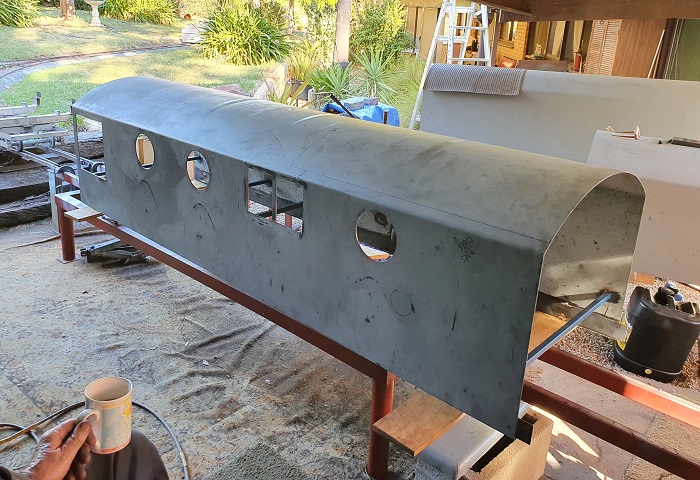
The body is of 3mm thick rolled steel plate which was done at a plate rolling factory in Adelaide. Although very heavy it greatly helps in tractive effort! The NSUs were very simple bodies with very little detail except for the centre doors and round side windows. The bodies were then cut to accommodate the driver's seating area and the rear plate was welded on.
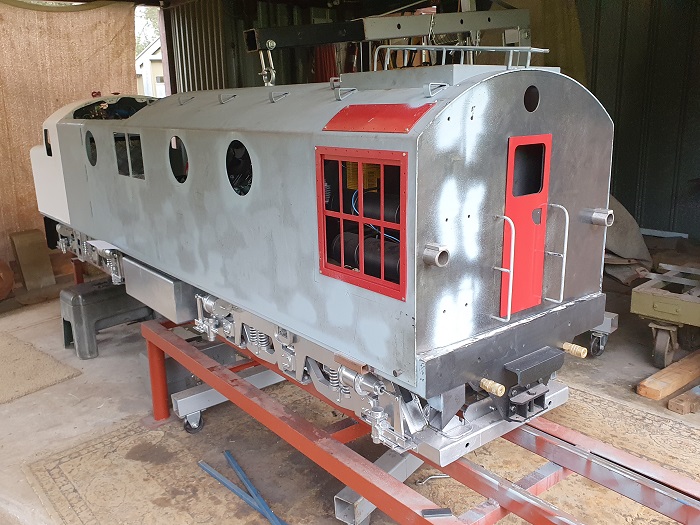
The body has been added to the frames, now with extra detail added. A section of the body roof has been removed from behind the cab, this will accommodate the driving controls and a seat for the driver.
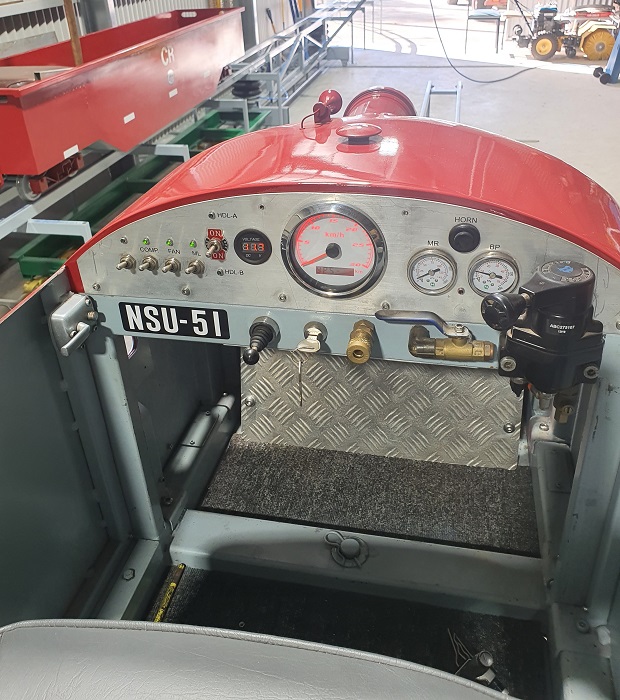
The driving position of the model locomotive. By this time the locomotive is fully painted, is operational, with a few more details to be taken care of.

A partially completed bogie. The wheelsets (wheels and axles) were turned by a machine shop largely because we could get them very cheap and I was anxious to get started on the bogies. We do have two lathes and have turned many wheels before but they take a lot of time to do! We then used our 10 ton press to push them together fitted with the required sprockets.
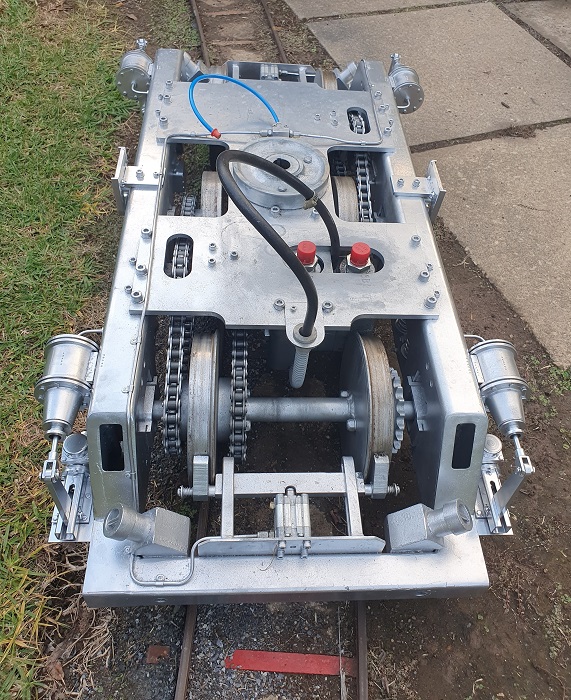
The completed bogie showing the chain drive to all three wheelsets, though the centre wheelset has no flanges. Power to the chain drive is provided by an hydraulic pump.
The bogies are 4mm thick steel tube of 150mm x 50mm laser cut to the required dimensions as per rough drawings based on the real thing. "Modellers license" was used to allow certain things to be altered to suit miniature scale however the general representation of the bogie came out quite good.
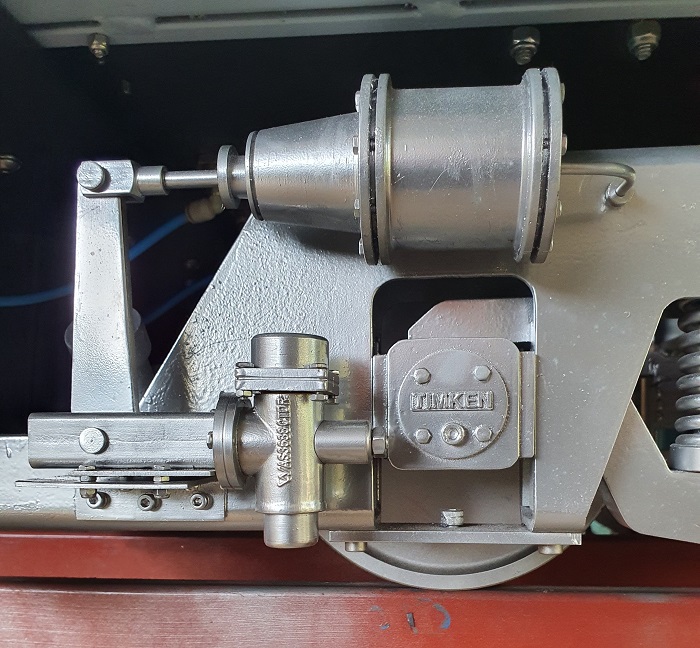
The brake cylinders, rodding and actuators were crafted by Karl senior. There are a total of eight per locomotive.

Sadly the locomotive is not powered by a scaled down Sulzer 6LDA28 diesel engine. In its place is a modern day Honda GX630 petrol engine of about 22hp. A toggle joystick mounted in the cab drives a linear actuator located alongside the engine which in turn pulls or pushes the throttle cable as required. (Karl senior is a genius at this type of stuff so most of that was his doing)!!! In fact most of the electrics on the loco is my dads doing! The Honda engine drives an hydraulic pump which in turn powers a bogie mounted hydraulic motor connected by a chain drive to all three axles.
Only the rear bogie is powered, the leading bogie is not powered due to the space needed for the driver's position and the operating controls, the idea of having high pressure hydraulic lines and similar fittings near to the driving position was not felt to be a good idea.
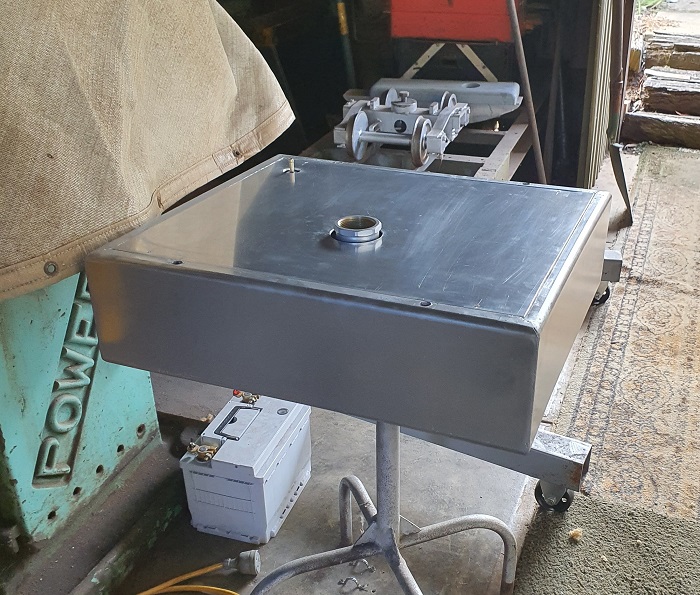
The fuel tank was built by Karl's brother Mark, a master plumber. The tank is used to supply petrol to the Honda engine.
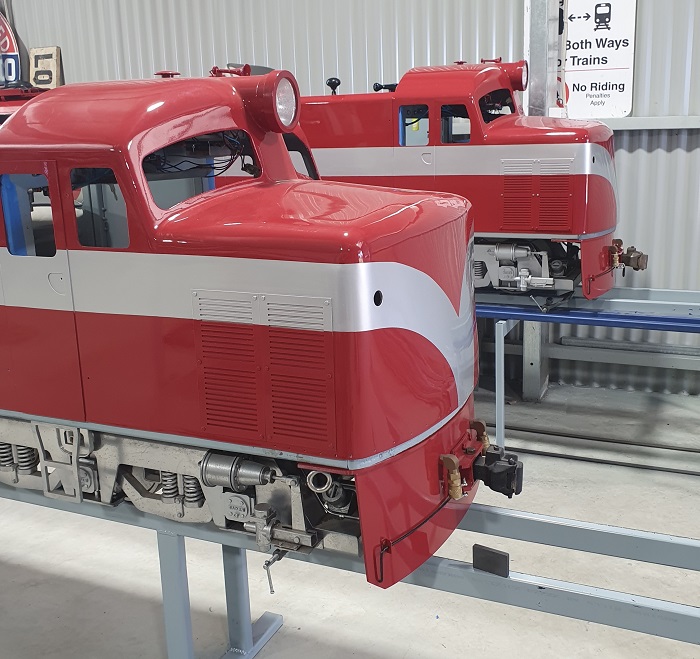
Painting of the locomotives has been completed, various trim, glazing and other details are to be added later.
The bogie mounted brake equipment (the brake cylinders, rodding and the slack adjusters) are all cosmetic. The actual brake cylinders are mounted at each end of the bogie frames between the wheels utilising a small brake cylinder set to about 40PSI. An additional air brake system operated from the cab controls the air brakes on the carriages. Much like the real thing! Being hydraulic however almost makes the air brake system unnecessary as the hydraulics is strong enough to retard the train when a stop is required. The air system is only really used to hold the train stationary. It has proved to be a very simple and reliable brake system.

Roof detail at the radiator end of the locomotive. The locomotive fan at the rear was one part where diversion from the prototype took place. The fan was made to fit a square box design rather than suit the curved body roof. This was done largely to allow the fitting of a standard car mounted radiator fan which could be replaced easily should it fail in service.
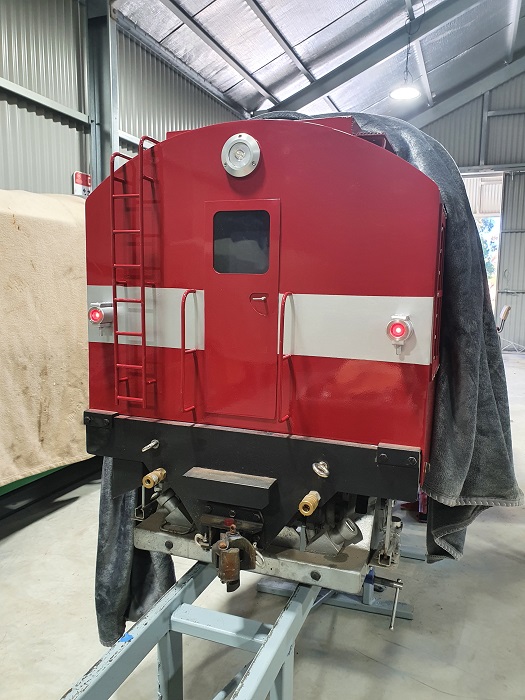
The rear end (No.2 end?) of one of the NSUs.
Many of the locomotive parts such as the headlight and marker lights are commercially available, with minor modifications to make them suit the loco!
The rear of the locomotive differs a lot from the real thing, it was designed to be able to lift up and pivot at the rear using a battery drill attached to a screw drive and the whole body lifts up!

NSU 52 sits on its road trailer in preparation for an adventure somewhere. The locomotive is thought to weigh between 700kg - 800kg.

Karl senior takes NSU 51 out for a trial run!
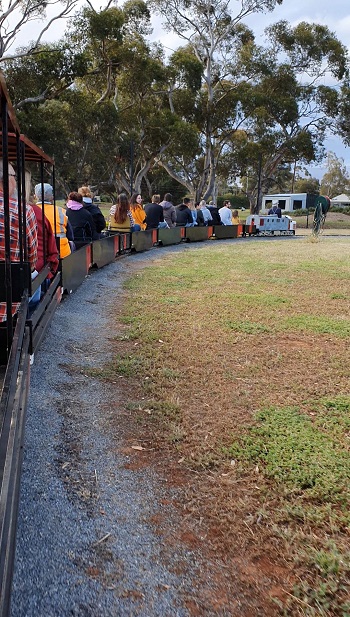 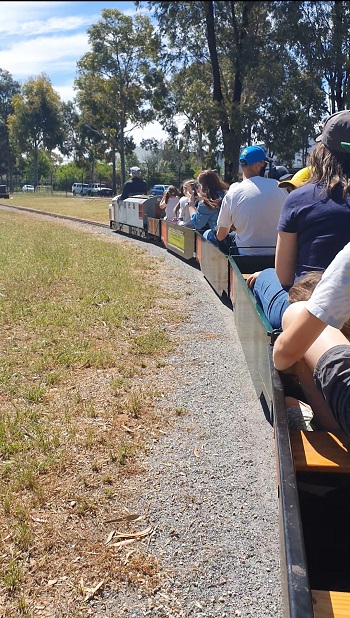
One of the NSU's, still in undercoat, undergoes testing at the Penfield Model Engineering Society located in the district of Salisbury, near Adelaide, South Australia. The locomotives are quite powerful. They have been hauling over a dozen carriages each with four adults per carriage.

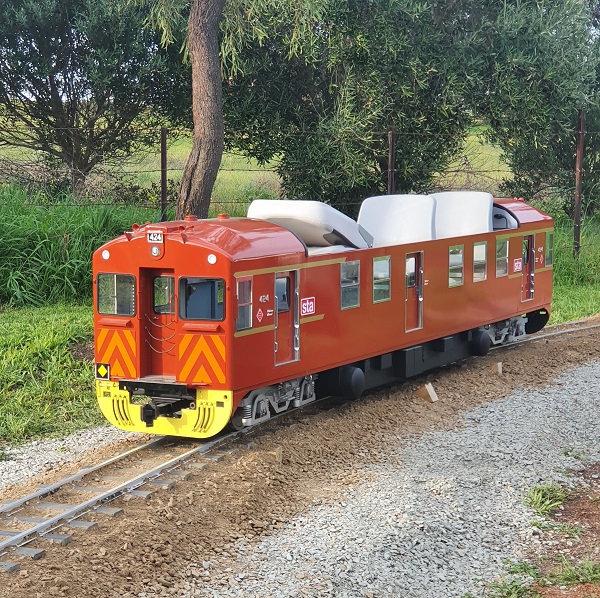
A 7 1/4 inch gauge 'Redhen' railcar built by Karl, Karl & Mark. The Redhen railcar design was largely an Australian version of the American Budd car design modified for metro use. They began construction in 1955 right through to 1971 with 111 built at the Islington workshops in Adelaide. The South Australian railways also made a similar type known as the "bluebirds" for our country trains and they were very popular. Many of both types are still around today in SA in either museums or operating as crew cars on interstate freight trains. The Redhens were diesel-hydraulic and were built for the 5ft 3in / 1600mm gauge. Most were powered using GM engines but a few had Rolls-Royce, though the GMs were considered the more reliable. They were confined mainly to the metro area of Adelaide however they have ventured all over the state's broad gauge network when they were occasionally used for staff picnic trains or hired out by railway enthusiast groups.
The model Redhen was only intended to haul itself and perhaps one or two carriages, so it was battery electric using two deep cycle truck batteries located in the non driving end. The batteries will provide for a full day's service without fail. A battery charger was installed above the batteries so at the end of each operating day all that was need was to plug it in to recharge.

Other Australian Sulzers:
Commonwealth Railways NSU Class
Commonwealth Railways NT Class

Page added September 20th 2023.
Return to site menu
| 


















![]()

![]()
![]()